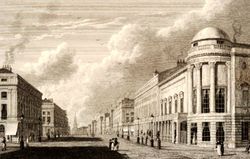Argyll Rooms
Opened in 1806 and located on Little Argyll (also spelled 'Argyle') Street , near King and Regent Streets, the former mansion of the Duke of Argyll now operates as a subscription-only club with a license to host music and dancing, and the occasional masked ball. Entry is by voucher, at the recommendation of a current member.
Description
Taken from The Picture of London of 1809:
FASHIONABLE INSTITUTION, ARGYLE STREET.
The fanciful elegance with which the internal parts of this building are fitted up, reflects the highest credit on the taste of Colonel Greville, the founder of the institution, from whose design, and under whose direction, the whole has been executed. From the following description, some idea may be formed of the general effect.
The entrance and lobbies are ornamented with Corinthian pillars, and illuminated with gilt lamps. On the ground floor are three spacious supper rooms; the first of which is of a grey colour, hung with scarlet drapery; the paper of the second, is a stone-colour and green trellis, and the drapery is a rich salmon colour, lined with pea-green; the third, though not so superb as the former, is fitted up in a corresponding style, and the whole are brilliantly illuminated, with glass and gilt lamps and chandeliers.
The grand saloon, which is employed both for the purpose of theatrical representation, and as a ball room, is of an oblong form with elliptical terminations. On each side, and over the entrance, are three tiers of boxes, amounting in the whole to about four and twenty. The first range above the ground tier, is ornamented with elegant antique bass reliefs in bronze; the upper tier is of aetherial blue, decorated with scrolls in stone colour, and both are inclosed with rich gold mouldings. Over each box, is a beautiful circular bronze chandelier, with cut glass pendants; the draperies are of scarlet, and the supporters between the boxes represent the Roman ox, and fasces in bronze and gold.
At the opposite end are the orchestra and stage, over which is the following appropriate motto, “Sollicitae jucunda oblivia vitae.” The walls of the middle space, which is of an ample size, are superbly ornamented with ranges of Corinthian pillars, representing porphyry, with capitals of gold. On the intermediate pannels, which are surrounded with borders of blue and gold, are bass reliefs, in stone colour, as large as life, the subjects of which are admirably adapted to the purpose for which they are employed.
On each side of this magnificent room, are tiers of benches, covered with scarlet, over which are suspended eight superb glass chandeliers, and the whole internal space is marked out with chalk, in the most fanciful manner. Contiguous to this are a refectory, painted with landscapes and wreathes of flowers, and a billiard-room, fitted up with singular neatness. On the other side, is a spacious chamber appropriated to cards, the ceiling of which is richly painted, and the windows are hung with scarlet drapery.
Adjoining this is a small apartment, called the blue room, decorated in the most pleasing and elegant style. The drapery is of light blue, and the sophas with which the room is compleatly surrounded, are all of the same colour; the walls are ornamented with much fancy, to harmonize with the furniture, and in the middle of the ceiling, which represents the open sky, is an eagle suspending a chandelier of bronze and gold. In short, the whole building is fitted up in a manner the most superb and tasteful that can be conceived. The first-rate performers, both vocal and instrumental, are engaged, and theatrical representations, concerts, balls, and masquerades, alternately succeed each other in elegant variety. No expence is spared to render this at once the most splendid and commodious place of amusement in the metropolis. It is supported by subscription amongst the principal nobility, for whose use it is exclusively established.
https://www.regencyhistory.net/2017/09/the-argyll-rooms-in-regency-london.html
https://en.wikipedia.org/wiki/Argyll_Rooms
